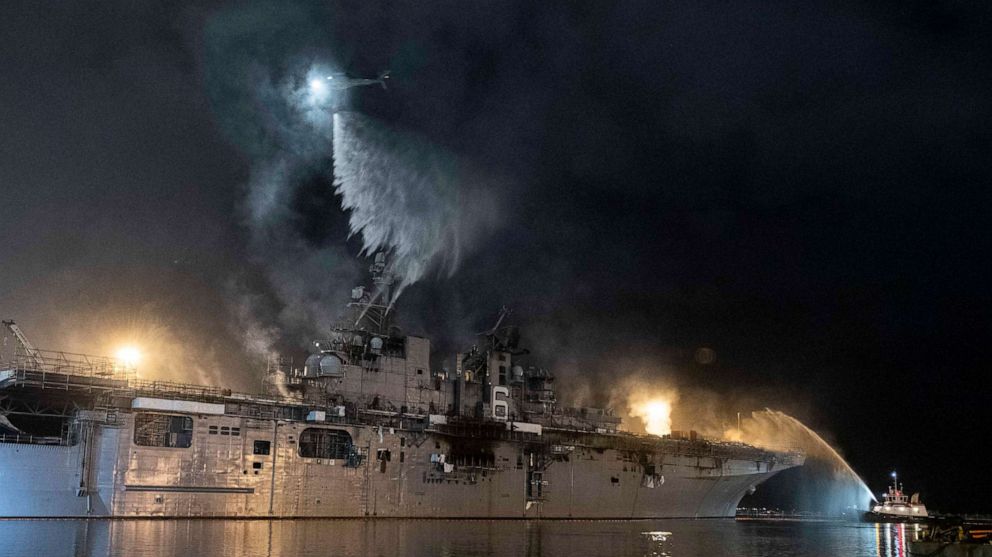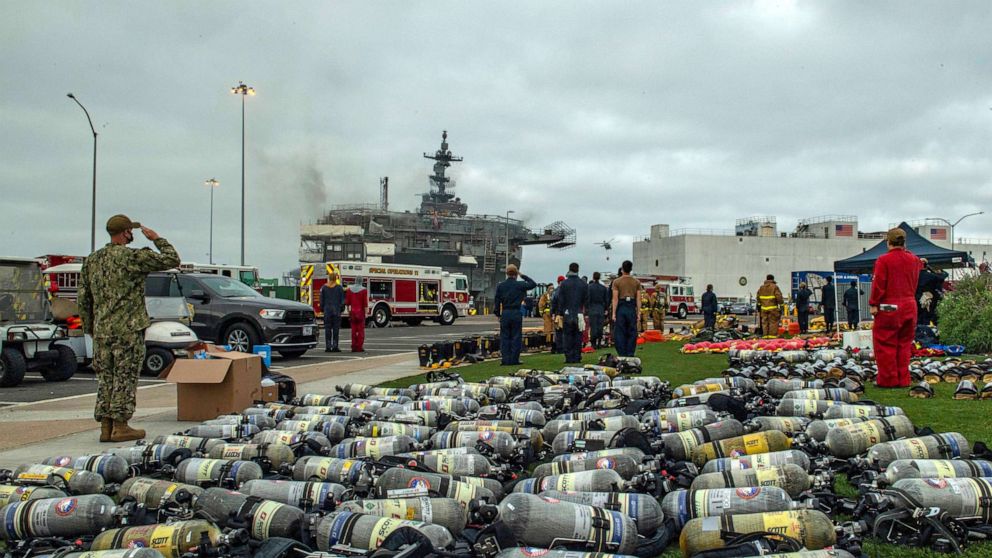Work continues to contain fire on Navy ship thought extinguished overnight
Defense officials say it's too soon to tell what the ship's future will be.
The U.S. Navy said that at least one fire continues to burn aboard the USS Bonhomme Richard, as progress is being made in extinguishing the fire that has raged in San Diego's harbor since Sunday morning.
A defense official told ABC News that as of Tuesday evening the fire was 80% contained.
Defense officials acknowledged that the fire has caused serious damage aboard the ship and that they face tough decisions about the ship's future, including whether the ship will be able to continue in service.
"The ship is stable and the structure is safe," said Rear Adm. Philip Sobeck, the commander of Expeditionary Strike Group 3 said at a news conference Tuesday in San Diego to update the efforts to extinguish the blaze.
Sobeck said there is one confirmed fire in the forward section of the amphibious assault ship that firefighters were only able to access earlier on Tuesday. There is another heat source in the rear of the ship that may or may not be a fire.

"The challenges remaining, obviously are getting that fire out completely," said Sobeck. "And then once that occurs, we'll then go space by space to make sure that each and every compartment is cool."
Defense officials told ABC News that overnight it appeared the last fire aboard the ship had been extinguished only to reignite again.
Sobeck said it's still too early to tell if the ship will be able to remain in service given the amount of damage believed to have occurred. One official described the fire reaching temperatures of 1,200 degrees.

A Navy team has arrived in San Diego to be in place once the fire is extinguished and carry out an initial damage assessment of just how severe the damage has been to the ship.
After the assessment is completed a defense official said "some hard decisions will have to be made" about the ship's future.
Commissioned in 1998 the USS Bonhomme Richard is estimated to have cost approximately $750 million, the ship is one of eight Wasp-class amphibious assault ships that are no longer in production. A replacement ship would likely come from the new America-class of amphibious assault ships that could cost $3.4 billion.
Sobeck said the fire did not cause major damage to the ship's four main engineering spaces and that "the risk is very low" to the ship's fuel tanks, which contain a million gallons of fuel.
The fire is believed to have started in the aft section of the ship near its "well deck," where Marine Corps vessels are stored when the ship is at sea.
It is believed that from there the fire moved quickly to the wide open hangar area, located above the well deck that maximized the fire's spread and intensity.
"For this class of ship, the open area that is above the vehicle storage area is all open. It's a big hangar. And so once the fire hit that amount of oxygen it then found other ways to go up some ventilation -- all the things where, you know, the fire sees space and oxygen, that's what fuels it, and that's what happened," said Sobeck. "And so then it went off to the races."
Navy helicopters have dropped 1,200 buckets of water onto the ship's deck and Navy tug boats are spraying the side of the ship, all in an effort to cool the ship's hull.
Sixty-one personnel, including 38 sailors and 23 civilians, have been treated for minor injuries including heat exhaustion and smoke inhalation. All of those personnel were treated and released from the hospital.




